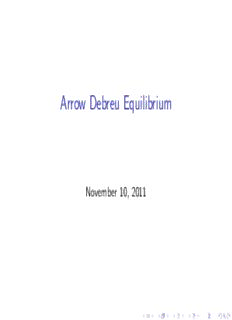
Arrow Debreu Equilibrium PDF
Preview Arrow Debreu Equilibrium
Arrow Debreu Equilibrium November 10, 2011 ◮ Θ = {s ,...s } - the set of (unknown) states of the 0 1 S world assuming there are S unknown states. ◮ information is complete but imperfect ◮ n - number of consumers ◮ K- number of physical commodities ◮ m number of firms ◮ this method proceeds by incorporating the state dependency directly in to the allocation - an allocation lies in X = RKnS a list of consumption plans for each individual in each state, ◮ AD is kind of Walrasian equilibrium ◮ each firm has a state contingent production set Y ⊂ RK js ◮ an allocation {x } if there is a collection of state i i=1,...n contingent production plans {y } satisfying js j=1,...,m,s=1,...S y ∈ Y for all j and s and js js n m x ≤ y is js i=1 j=1 X X for each s ◮ Preferences subjective expected utility - πi - the s probability with which consumer i thinks that state s will occur ◮ consumer i’s utility for allocation x depends only on x i and is given by U (x) is S πius (x ) i s=1 s i is P ◮ auctioneer announces a price vector p ∈ RkS (one price for each commodity in each state) ◮ each consumer owns the share λ of firm j’s shares and a ij state contingent endowment ω is ◮ firms maximize profits ◮ an Arrow-Debreu equilibrium is a Walrasian equilibrium for the problem above is a triple (p∗,x∗,y∗) ◮ (profit maximization) each firm’s state contingent production plan y∗ maximizes p∗y subject to y ∈ Y j j j j ◮ (utility maximization) each consumer’s consumption plan x∗ = {x∗} maximizes i is s=1,...S πiu (x ) s i is s X subject to S S S m ∗ ∗ ∗ ∗ p x ≤ p ω + λ p y s is s is ij s js s=1 s=1 s=1 j=1 X X XX ◮ (feasibility) n n m ∗ ∗ x ≤ ω + y is is js i=1 i=1 j=1 X X X for each state s ◮ the preferences above satisfy the private value property, reasonable monotonicity restriction then ensure that the first Welfare Theorem holds so that an Arrow Debreu Equilibrium is Pareto Optimal which means that every Arrow Debreu equilibrium is interim efficient ◮ every Arrow-Debreu equilibrium allocation is ex post efficient provided πi > 0 for each i and s. s ◮ Proof: Let {x∗,y∗,p∗} be the Arrow Debreu equilibrium allocation. By the first welfare theorem, there does not exist an alternative feasible allocation {x,y,p} such that S S πius (x ) ≥ πius (x∗) s i is s i is s=1 s=1 X X with strict inequality holding for some i. ◮ Suppose that the allocation {x∗,y∗,p∗} is not ex post efficient. Then there is an alternative feasible allocation {x′,y′,p′} such that us(x′) ≥ us(x∗) i is i is with strict inequality holding for at least one i and s. But then it is immediate that S S πius (x′) ≥ πius (x∗) s i is s i is s=1 s=1 X X with strict inequality holding for at least one i. This contradicts the first welfare theorem.
Description: